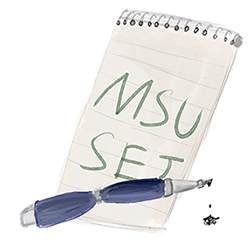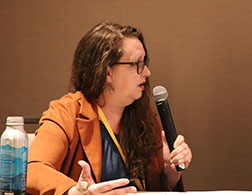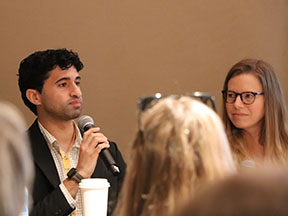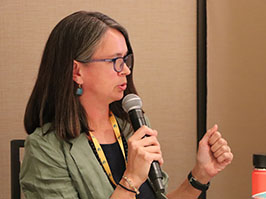 This is the 4th in a series of articles about reporting skills by Knight Center students who attended the 2025 Society of Environmental Journalists conference.
This is the 4th in a series of articles about reporting skills by Knight Center students who attended the 2025 Society of Environmental Journalists conference.
By Mia Litzenberg

Mia Litzenberg
Experts are looking beyond climate resiliency to build adaptive capacity, a process for navigating changes to cultural lifeways that promotes living well – not just bouncing back.
The ability to be climate-resilient suggests that people will bounce back to their previous ways of life – a paradigm that is being reshaped altogether.
“I’m keenly aware of the problematic word ‘resilience,’ especially as an academic,” said Knowledge Exchange for Resilience Executive Director Patricia Solís. “We often are now using adaptive capacity to signal that it’s a building process.”

Patricia Solis discusses her work on climate adaptation at Arizona State University. Credit: Mia Litzenberg
Solís spoke on the panel “Beyond Worst-Case Scenarios: Building a Vibrant Subculture of Climate Adaptation” at Arizona State University in April. The panel was part of the annual Society of Environmental Journalists conference.
Panelist Nabig Chaudhry, the director of climate adaptation strategy at the climate literacy nonprofit Probable Futures, said there are two things that can be done to address climate change.
While the first is to reduce greenhouse gas emissions through mitigation, the second is to build adaptive capacity.
“We’re seeing a lot of new ideas pop up of how we can rebuild these systems, hopefully back in the future, that are better because they have been torn down,” Chaudhry said.
Chaudhry said the goal at Probable Futures is to step beyond the predominant climate narrative that most people don’t have a hand in solving the climate crisis and that it is a perpetual apocalypse where everything falls apart.

Nabig Chaudhry (left) and Eliza Barclay (right) participate in a panel on climate adaaptaton at the Society of Environmental Journalists conference in Tempe, Arizona: Credit: Mia Litzenberg
“We wanted to explore what the possible futures were in between those – where we could help people figure out what it means to live well in a changing climate,” Chaudhry said.
“There isn’t really going to be a giant solution. Adaptation is going to come in many different forms across many different scales,” Chaudhry said.
Solís said resolving failing systems is a significant part of a broader cultural shift towards climate adaptation.
Solís helped publish a multi-scale heat solutions guide for mobile homeowners in collaboration with the Arizona Association of Manufactured Home Owners.
Through the community heat research she helped create, advocates were able to get a law in Arizona passed that makes it illegal for landlords to prohibit owners of mobile homes from installing air conditioning.
“One of the reasons why I do believe that it passed was because it was a zero dollar bill. There was no investment necessary,” Solís said.
Although this policy enabled individuals to address extreme heat problems, Solís said she was personally frustrated that most solutions are pushed down to the individual level in the first place.
“Please, please, can we talk about system solutions?” Solís said. “Those do require those kinds of investments, whether they are adaptation or mitigation.”
One example of a cultural adaptation solution is the concept of time migration, in contrast to place migration.
The concept appeared in the book, “A Climate Vocabulary of The Future,” which was brought into the discussion by the author, Herb Simmens, who attended the panel.
When it comes to the effects of climate change, such as heat, one option is to physically move to a new geographic location.
Another option, Simmens said, is to shift activities to times when it is not as hot. Some cities have already appointed night mayors, but Simmens suggested that they could start adding a climate portfolio to shift daily activities to evening hours.

Kelsey Fitzgerald discusses her work on relationship building with Indigenous communities through the Desert Research Institute to create climate adaptation solutioins. Credit: Mia Litzenberg
On top of system adaptation solutions, Native Resilience Project communications coordinator Kelsey Fitzgerald addressed how cultural adaptation can be made on the relational level among individuals or groups of people.
“The Native Resilience project is focused on supporting climate adaptation efforts in Indigenous communities, primarily in the Western United States, by bringing together Indigenous knowledge and sort of Western-style climate science,” Fitzgerald said.
A key part of bridging these two perspectives together is through two-way information sharing. The project works with U.S. Department of Agriculture (USDA) Climate Hubs, which produce regionally-specific climate science on natural resource industry adaptation, and Indigenous communities, who are knowledgeable about changes happening on the ground.
In that practice, Fitzgerald and her team help establish information pathways for the USDA Climate Hubs and Indigenous communities to collaborate on climate adaptation strategies.
“I think the truth is we don’t know what’s going to happen, and we’re going to be a lot better off if we can inspire a lot of people to start doing whatever they can do in their lives than if we’ve scared everybody into total inaction and feeling like there’s no hope for the future,” Fitzgerald said.
She emphasized sharing localized examples of climate solutions, where people can see positive outcomes for their community or adjacent cities tackling similar challenges.
Chaudhry said, “People will adjust. But whether we adapt well or not depends on the stories we hear, the guidance we receive, the imagination we’re able to expand.”
